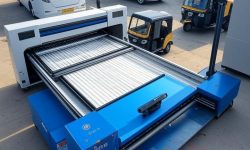In the modern age of rapid infrastructure development, the construction industry is embracing technology like never before. Among the tools revolutionising the sector, laser cutting machinery has emerged as a game-changer. Known for its precision, speed and efficiency, laser cutting is now playing a crucial role in everything from structural steel fabrication to architectural detailing.
What is Laser Cutting?
Laser cutting is a technology that uses a high-powered laser beam to cut or engrave materials such as steel, aluminium, and composites. The process is highly accurate, using computer-aided design (CAD) to deliver consistent and complex shapes. Unlike traditional mechanical cutting, laser cutting is contactless and therefore reduces tool wear and the risk of material deformation.
Key Applications in the Construction Industry
1. Structural Steel Fabrication
Laser cutting enables accurate shaping of steel beams, angles, and brackets used in structural frameworks. This ensures tight fitting, faster assembly, and stronger builds—vital for high-rise buildings and bridges.
2. Pre-fabrication of Building Components
Construction is increasingly moving towards modular and prefabricated designs. Laser-cut parts like wall panels, roof trusses, and staircases are pre-made offsite with unmatched accuracy and then assembled onsite—saving time and reducing labour costs.
3. Architectural Metalwork
Laser technology allows designers to craft intricate patterns for decorative metal facades, railings, gates and cladding. This not only boosts aesthetic value but also increases efficiency in production.
4. HVAC and Plumbing Layouts
Cutting ducts, pipes, and ventilation grills with lasers ensures smooth edges and precise fitting, improving performance and installation speed.
Advantages of Laser Cutting in Construction
• Precision & Consistency
Laser cutters offer micrometre-level accuracy, which is essential for both structural integrity and aesthetic detail.
• Speed & Efficiency
Compared to traditional cutting methods, laser machines can cut faster without sacrificing quality. Complex patterns that may take hours by hand can be done in minutes.
• Reduced Waste
Thanks to precision cutting, there’s minimal material wastage—crucial when working with expensive metals or composites.
• Automation & Integration
Laser cutting systems can be integrated into automated production lines, allowing for seamless workflow from design to final assembly.
Real-World Examples
- High-Rise Projects in Dubai: Steel frames and façade components are laser-cut offsite to exact measurements and assembled rapidly onsite.
- Modular Housing in the UK: Companies use laser systems to pre-cut entire steel frame units that can be assembled in a matter of days, cutting down build time by up to 50%.
- Stadium Construction in Europe: Complex architectural shapes and supports for roofing systems are achieved using large-format laser cutters.
Future of Laser Cutting in Construction
With the rise of smart construction and Industry 4.0, laser cutting machines are now integrated with IoT systems, enabling remote monitoring, predictive maintenance, and real-time quality control. As sustainability becomes a global goal, the precision and low waste output of laser technology will be more critical than ever.
Conclusion
Laser cutting machinery is no longer confined to manufacturing plants it is reshaping the way we design and build. By enhancing precision, reducing time, and supporting innovative architecture, laser technology is cementing its place as a cornerstone of the modern construction industry.
Whether you’re a contractor, architect, or engineer, investing in or partnering with laser cutting solutions could be your gateway to faster, smarter, and more sustainable construction.










